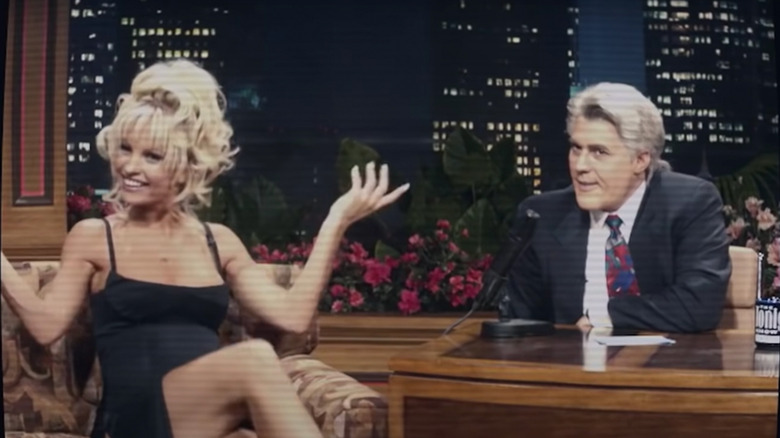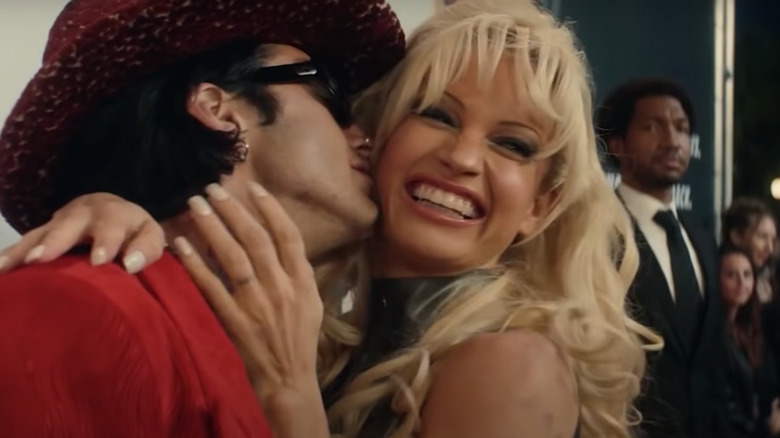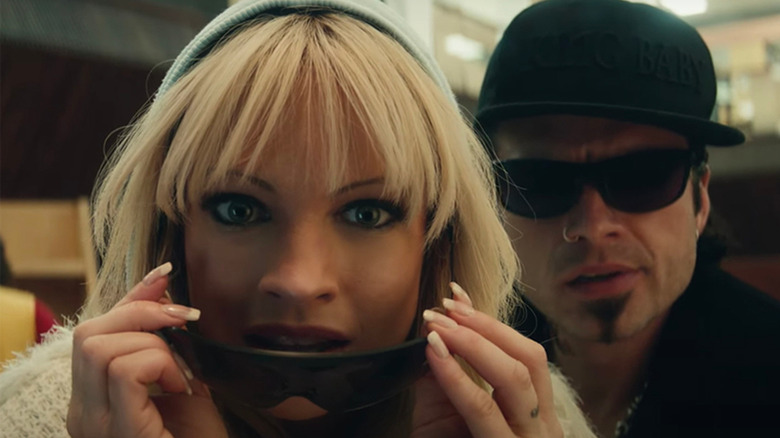Can Pam & Tommy Avoid Being Exploitative?
"Pam & Tommy" opens with a shot of a period-accurate television screen. On it: Pamela Anderson, sitting for an interview with Jay Leno — or rather Lily James as Pamela Anderson. Platinum blond wig, penciled-on eyebrows and prosthetic bust are all present and accounted for. It's the kind of transformation that invites awards season prestige, but James makes her performance about more than a mere imitation of the "Baywatch" star. When Leno asks about "the tape," her response is a coy, "What tape, Jay?" Even if you were too young to really know who Pamela Anderson is, you can tell that James has done her homework.
The tension, palpable even before the infamous "tape" is mentioned, only mounts as Leno glibly continues. We press in on the television set, and it brings Anderson's discomfort into clear (albeit still grainy; this was the '90s) focus. Leno asks her what it's like, "to have that kind of exposure." Then all pretense drops. Pamela chuckles humorlessly, tongue tucked between brilliant white teeth. Her eyes seem to scream for help.
It's haunting, watching her through a screen and yet another, older screen. It puts distance between voyeur and victim, and effectively reminds us that this all happened 25-plus years ago. As much as we'd like to help Pamela, save her from what's to come — or, in the case of this scene, what's already started to unfold — it's much too late for that. She's on her own, and all we can do is watch.
That scene, that feeling, sets the tone for the entire series, an eight-episode retelling of the fallout that followed the release of a sex tape between Anderson and then-husband Tommy Lee. Many are at least familiar with the story, but few knew that the tape was actually stolen by Rand Gauthier, a disgruntled electrician who'd been fired without pay while working on Lee and Anderson's home renovations. That familiarity still casts a sense of dread over their fleeting four-day courtship, and on the wedding that follows. But with Craig Gillepsie ("I, Tonya") helming the first three episodes of the series, it's almost buried beneath the gaudy sleaze that makes that era so appealing today.
"Pam & Tommy" is the latest in a long stretch of media to advocate for the misunderstood women of the '90s, banking on the nostalgia that clunky TV sets, Hi8 cassette tapes, over-drawn lips — and yes, all those scandals — undoubtedly evoke. Anderson's life plays out on wibbly screens throughout the series, her likeness broadcast (at times without her consent) on nearly every television in America. The series makes a bold statement about so many things, consent included, but it doesn't ever seem to pause and ask whether something like "Pam & Tommy" is playing by the same rules it sets for everyone else.
Were Pam & Tommy Actually Involved in Pam & Tommy?
Anderson hasn't been outright vocal on her stance of "Pam & Tommy," but her silence inarguably speaks for itself. Neither she nor Tommy Lee are involved with the project in any capacity, though not for lack of trying — at least on the part of Lily James, who told Porter that she'd reached out to Anderson but failed to make contact. "I was really hopeful that [Anderson] would be involved... And I was very hopeful that we would be in touch right up until we started filming."
The series showrunners, D.V. DeVincentis ("American Crime Story") and Rob Siegel, also made a kind of effort to reach out to Anderson, but not before scoring the rights to the story. They seemed to have already made up their mind about the series, content to move forward whether they could secure Anderson's blessing or not. "We wanted to let Pamela Anderson know that this portrayal was very much a positive thing," said DeVincentis to Entertainment Weekly. "We cared a great deal about her and wanted her to know that the show loves her."
Unfortunately, "love" is not quite the same thing as compliance. Calling something positive doesn't always make it so, either — but that didn't ultimately seem to matter for a story so embedded in the public zeitgeist. "What we're trying to do is really change the narrative and your perspective of what happened," Gillespie told EW of the team's intentions.
DeVincentis added, "So much of this show is about the behind-the-scenes strength and heroism of Pamela Anderson in the way that she dealt with and got herself through it."
Still, without Pamela's actual input, the "Pam & Tommy" writers found inspiration elsewhere. The series draws heavily from a Rolling Stone tell-all published in 2014. The article leans on Gauthier's retelling of the event, as does the series, which dedicates whole episodes to Gauthier's life, his childhood, and his backstory. All that context wouldn't be so bad — he was wronged pretty gravely by Tommy Lee, after all — if the series had done half as much for Anderson. The series does eventually get around to redeeming Pamela's tarnished image, but it skirts over a lot of the trauma that the actress endured in her own life — and not just at the hands of the sex tape.
Anderson has been candid about her history of sexual assault in the years since the tape was leaked. Her abuse at the hands of Tommy Lee was also well-known before the couple divorced in 1998. Those circumstances are neatly glossed over (even omitted) in the series, but it's likely for the best. "Pam & Tommy" is a series written, produced and directed almost exclusively by men. Female directors and writers are involved in later episodes, those that deal with the bulk of Anderson's "strength and heroism," but such a plotline could be dangerous territory to dip into without her own counsel.
How Much is Too Much?
It's hard to root for a series like this, well-crafted as it may be, knowing it goes against the wishes of at least one party. Courtney Love, a close friend of Anderson, slammed the series when promotion first began in 2021, but directed the bulk of her disapproval to Lily James, "whoever the f*** she is." A lot of the backlash against "Pam & Tommy" has fallen on the actress. It makes sense that she — and Sebastian Stan, who plays Tommy Lee — are taking the brunt of the criticism for the series. They are, after all, the faces of it. Stan worked with Gillepsie on "I, Tonya," so he's no stranger to the lurid '90s revisionism that's become so popular recently. That could also explain his keenness to take on another role in the same truth-based vein.
There's certainly something tantalizing about portraying a person who really lived, whose mannerisms and quirks can be plucked from the treasure trove of archival footage out there and studied with near-scholarly dedication. James, to her credit, makes an absolutely intoxicating Pamela. Stan too does a standup job embodying the mania and surprising sweetness of Tommy. But apart from "reframing the narrative" around the maligned couple, what's the point of dredging up such a painful experience for all involved? What is "Pam & Tommy," if not a vehicle to show that James and Stan can, that the directors and writers can? Does ability always justify necessity? Did the story need to be told at the expense of those directly involved?
There's no doubt that "Pam & Tommy" will have a hand in changing public perception around Pamela Anderson, but it will also undoubtedly renew public interest in the sex tape that started it all. The series does respect the couple's boundaries by omitting the more explicit entries of the tape, but that could very well just encourage the more curious among us to seek it out elsewhere, which fills me with more dread than a reenactment ever could.
As entertaining as these retrospective explorations can be, sometimes it's best to leave things where they are. We may want to reach back through 25-plus years of pop culture history and connect with Pamela, but is that what she herself wants? It's in the past. Whatever happened happened. It's a noble effort to try and redeem these misunderstood women of the '90s, but if Pamela no longer cares what others think of her, who are we to disturb the peace she's worked so hard to foster since?
"Pam & Tommy" is currently streaming on Hulu.


